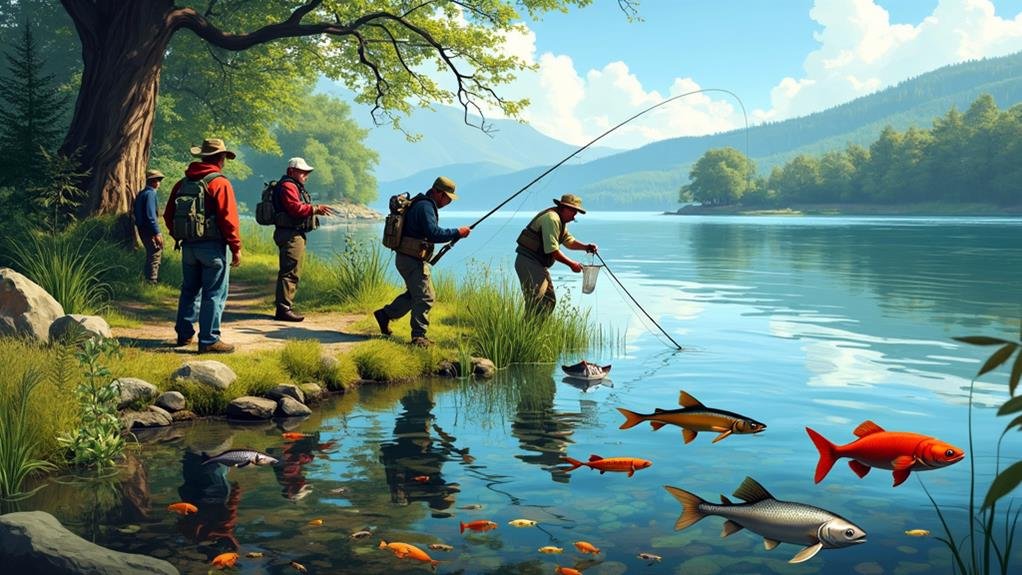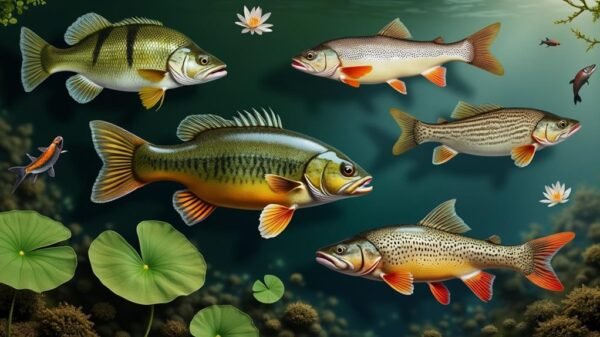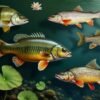Recognizing freshwater fish species can be an exciting journey! Begin by observing the fish's body form and dimensions, as these can reveal its species. Take note of any color designs and unique markings; these are crucial identifiers. Inspect the fins and tails for configuration—various species have distinct structures. Pay attention to the mouth shape and its position, which can provide clues about feeding habits. Keep in mind their habitat preference; certain fish thrive in particular environments. Using field guides can enrich your knowledge. Engaging with local fishing communities offers valuable perspectives. Stay tuned to explore even more tips on this fascinating subject!
Understanding Freshwater Habitats
Freshwater habitats, comprising rivers, lakes, ponds, and wetlands, occupy about 0.8% of the Earth's surface. Despite their small area, these environments support a remarkable array of aquatic life. Each habitat presents distinct conditions that cater to various fish species, making an understanding of these ecosystems essential for anglers and nature enthusiasts alike.
When engaging in freshwater fishing, it's beneficial to learn the essential techniques and knowledge that can enhance your experience. For instance, rivers with swift currents attract fish species like trout and bass, while the calmer waters of lakes are home to species such as bluegills and catfish. Observing factors such as water temperature, depth, and surrounding vegetation can greatly influence which fish thrive in a particular habitat.
As you explore these aquatic environments, watch for signs of life. Bubbles rising to the surface, ripples breaking the water's calm, and shadows lurking below can all indicate the presence of fish. Embrace the adventure of discovering these ecosystems! The more you learn about freshwater habitats, the better equipped you'll be to identify the diverse fish species that inhabit them. So pack your fishing gear, and embark on the journey to connect with nature and its wonders.
Recognizing Physical Characteristics

When you're out fishing, recognizing the physical traits of various fish types can significantly enhance your success. Start by observing the shape of the fish. Some species possess long, slender bodies, while others appear more rounded. For instance, the rainbow trout typically showcases a streamlined, torpedo-like silhouette, ideal for rapid swimming. Additionally, understanding whether you're dealing with a coldwater or warmwater species can help refine your identification, as each category exhibits unique adaptations to their habitats, such as temperature sensitivity.
Next, focus on the colors and patterns. Vibrantly colored fish like the bluegill sport distinct markings for easy identification. Look for specific spots or stripes, as these often indicate particular species. The fins also provide valuable insights; certain fish, like the betta, have long, flowing fins, while others, such as the bass, may feature shorter, sturdier fins.
Don't overlook the size and mouth structure! Some fish, like the largemouth bass, have expansive mouths designed for consuming large prey, while others, like the sunfish, possess smaller mouths suited for nibbling on smaller food items. The positioning of the eyes can also be revealing; fish like the pike, characterized by high-set eyes, are often predatory.
Observing Behavioral Traits

Observing aquatic species in their ecosystems reveals significant insights into their identity. Fish display various interactions with one another and their habitats, offering clues to their classification. For example, bass exhibit aggressive tendencies, while sunfish are generally more docile. Noticing a fish pursuing another may indicate territorial behavior, aiding in species identification.
Understanding behavioral traits across different aquatic environments, such as lakes and rivers, is crucial, as each habitat typically supports specific fish populations, like common carp or bluegill.
Feeding patterns also play a key role in identification. For instance, catfish are bottom feeders, while sunfish actively hunt near the surface. This feeding behavior assists in differentiating species.
Additionally, the social structure of fish is important to note. Certain species, like minnows or shad, prefer to swim in schools, while others, like lone pike, are more solitary. Observing these dynamics enhances understanding of fish behavior and identification.
Utilizing Field Guides

A dependable field guide, such as the "Peterson Field Guide to Freshwater Fishes" or an app like "Fishbrain," can assist in identifying freshwater fish species. These compact resources contain essential information, enabling you to distinguish various fish by their colors, shapes, and sizes. When by the river or lake, having a guide allows you to compare what you observe with illustrations or photographs directly in front of you. Recognizing the traits of warmwater fish, like bass and catfish, versus coldwater species, such as trout and salmon, can enhance your identification abilities. Choose a field guide tailored to your local area, ensuring you receive precise information about the fish you may encounter. Feel free to take notes or highlight pages as you gain knowledge! Many guides also provide insights into habitat preferences and behaviors, enriching your understanding of each species.
When you see a fish, take your time to examine its characteristics: fin shapes, body patterns, and swimming style. Use your guide to help narrow down your possibilities.
Engaging With Fishing Communities

Connecting with fishing communities can significantly boost your knowledge of freshwater species and enhance your angling techniques. Joining local clubs or online forums allows you to meet like-minded fishing aficionados. You'll encounter individuals who share your enthusiasm and offer insights about nearby lakes and fish behavior. Additionally, discussing effective tackle, such as TRUSCEND Lifelike Swimbait Lures, will give you valuable tips tailored to specific fishing conditions.
Engaging in community events, like fishing tournaments or conservation initiatives, enables you to learn from seasoned anglers. These events are enjoyable and offer a platform to ask questions and exchange advice. Don't shy away from sharing your own fishing stories; every angler's journey is distinct, and your experiences could motivate someone else.
Following local fishing guides on social media is another great way to stay informed. They frequently post updates on prime fishing locations, seasonal shifts, and techniques that can enhance your success. Engaging with their content allows you to pose questions or seek further guidance.
Following Fishing Regulations

Responsible angling requires understanding and following fishing regulations. These guidelines protect aquatic life and ensure sustainable fishing for all enthusiasts. Before you cast your line, consult your local fishing regulations, which specify methods for capturing various fish species, including game fish like trout and bass. Regulations also outline size limits, bag limits, and designated seasons for specific species, such as salmon or catfish. Disregarding these regulations can result in substantial fines and diminish your fishing experience.
While the thrill of landing a trophy fish can be enticing, knowing the appropriate times and locations for fishing is crucial. Fishing regulations can differ greatly between lakes, rivers, and coastal areas. Certain regions may impose unique restrictions on species like pike or walleye, so thorough research is essential.
Additionally, securing the necessary fishing licenses before heading out is imperative. A valid license ensures compliance with local laws and contributes to conservation initiatives, allowing anglers to fish legally and responsibly. Embrace the joy of fishing while upholding environmental stewardship. By doing so, you support a thriving ecosystem and enhance the fishing experience for everyone. So gather your gear, stay informed, and venture into nature with appreciation for the great outdoors.
Practicing Ethical Techniques

Practicing ethical fishing techniques enhances your experience and safeguards aquatic environments for the future. When anglers fish responsibly, they not only savor the moment but also ensure that future generations can enjoy the same pleasure. For example, using high-quality lures from the brand Truscend can improve your fishing success while minimizing the impact on fish populations. Here are essential practices to consider:
- Catch and Release: After catching fish, handle them gently and return them to their habitat. This practice helps sustain fish populations and maintains balanced ecosystems.
- Use Appropriate Equipment: Ensure your fishing gear matches the species you aim to catch. Utilizing suitable tools reduces stress on fish and boosts your chances of a successful outing.
- Respect Natural Habitats: Avoid disturbing nesting areas and natural habitats. By preserving these environments, you allow fish to flourish and reproduce.
- Stay Updated: Familiarize yourself with local fishing regulations and guidelines. Being informed about your surroundings empowers you to make decisions that benefit both yourself and the ecosystem.



























